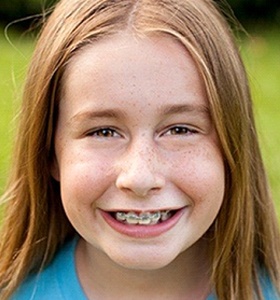
Phase I Pediatric Orthodontics – Jacksonville, FL
Proactive Care for Growing Smiles
 Actual Patient
Actual PatientAt Ortega Orthodontics, we believe early treatment can make a significant difference in the positive growth and development of a child’s smile. As a pediatric orthodontist in Jacksonville, Dr. Holland can provide what is known as Phase I Pediatric Orthodontics to children as young as 7. Not only will this proactive form of treatment work to improve aesthetics, but even more so, it will reduce the likeliness of more complex dental care later on in life. If you have a child who is nearing the appropriate age for an orthodontic examination, please do not hesitate to contact our office to schedule an appointment with Dr. Holland today.
WHY CHOOSE ORTEGA ORTHODONTICS FOR PHASE I PEDIATRIC ORTHODONTICS??
- Fourth-generation orthodontist from right here in Jacksonville
- Years of experience treating young children
- Warm, friendly, & highly skilled team
Why a Child Should See an Orthodontist Before the Age of 7
 Actual Patient
Actual Patient
In certain cases, early-age orthodontic treatment can have a significant impact on a child’s oral growth and development. The American Association of Orthodontists (AAO) recommends that all children should have a checkup with an orthodontic specialist no later than age 7. By age 7, the permanent teeth are beginning to erupt, so Dr. Holland can check for problems related to jaw growth, bite alignment, and the incoming adult teeth, enabling him to address issues as early as possible.
Does My Child Need Phase I Orthodontics?
 Actual Patient
Actual Patient
The only way to know for sure if your child should receive Phase I treatment is to schedule an appointment with an orthodontist in Jacksonville. Dr. Holland’s skillful eye will be able to detect problem areas, which will then allow him to recommend the appropriate treatment. However, there are a few signs that can make it easier to determine if early orthodontics is necessary, such as:
- Crooked or overcrowded teeth
- Speech impediment
- Large gaps between teeth
- Teeth that protrude
- Prolonged use of a pacifier or thumb-sucking that is causing abnormal development of the jaw
- Difficulty breathing
- Improper bite alignment
- Disproportionate jaw
How Does Phase I Treatment Work?
When Dr. Holland examines your child, he’ll primarily be looking at their teeth, jaw, and how they line up when the mouth is closed. He will also take some X-rays so he can view the teeth that have yet to come in. This way, he can see if your child has any current alignment problems. He’ll also be able to determine whether or not other developmental concerns are likely to worsen as they grow. He can then recommend whether or not your child would benefit from Phase I treatment, which is intended to give the incoming adult teeth all the room they need to come in straight.
To do this, he will have your child wear a series of removable oral appliances to bed that places a small amount of pressure on their teeth. If your child is still sucking their thumb by this age, he may also place a thumb crib in their mouth to help them break the habit. After a year or so, he will reexamine your child and see if they need to progress onto Phase II.
What Happens During Phase II?
Phase II usually consists of treatments you’re probably already familiar with, such as traditional braces. Phase I helps the adult teeth come in as straight as possible, while Phase II corrects any lingering alignment issues they might have. By undergoing Phase I, a child’s orthodontic problems can be greatly reduced, which means their overall time wearing traditional braces should be noticeably shortened or even eliminated altogether. Phase I can also prevent certain issues from becoming worse, such as those associated with thumb sucking.
In addition to braces, Dr. Holland can use other orthodontic appliances such as an RPE (rapid palatal expander) to fix crowding and retainers to help newly shifted teeth stay in place after braces have come off. By beginning orthodontic treatment as early as possible, a child’s overall treatment time can be drastically shortened, saving time and money for parents. The result will be a well-balanced, functional, and attractive smile that should bolster a child’s confidence for years to come.
Things to Remember
Children are much easier to treat with orthodontics simply because the bones in their face are continuing to develop. This is why early orthodontic treatment is important and beneficial. By addressing these issues ahead of time, we can stop problems before they start and mitigate the potential for worsening issues down the road. Instead of waiting until they are teenagers or even adults, our team at Ortega Orthodontics can give your child a chance to enjoy a healthier, more beautiful smile as they transition into adolescence and adulthood.
At Ortega Orthodontics, Early-Age Exams are 100% Free
An early orthodontic evaluation generally does not result in immediate treatment. After evaluating your child, we can make decisions regarding the best time to begin treatment, as well as put together the appropriate recall schedule necessary to monitor the eruption of the permanent teeth, the jaw, and their overall facial development.
Phase 1 Orthodontics FAQs
When Does Phase 1 Orthodontics Take Place?
Phase 1 orthodontics usually takes place while kids still have many of their baby teeth, typically between 6 to 9 years of age. This is the era when the loss of baby teeth begins, and when the permanent teeth start to sprout; undergoing orthodontic treatment during this time allows us to detect and fix any issues with this process. It also allows us to make adjustments to the teeth when they’re at their most malleable.
For this reason, the American Association of Orthodontists recommends that children see an orthodontist for an exam before seven years of age.
What Appliances Are Used in Phase 1 Orthodontics?
Phase 1 orthodontics is typically much less complicated than what patients get later in life. If your child’s teeth are overcrowded, for example, they may benefit from a palate expander that can create more space in the upper jaw. If a baby tooth is lost prematurely, we may offer your child a space maintainer that can allow the permanent teeth to grow in smoothly.
It’s rare for young children to need actual braces, and even when necessary, they’re usually only used to target select teeth.
Does Phase 1 Orthodontics Affect Diet & Nutrition?
Depending on the appliance your child receives, it may be necessary for them to make some select changes in their diet. If the appliance is removable, they’ll be able to take it off before meals, meaning that they can continue to eat what they normally would.
However, if they’re wearing braces or a palate expander, it may be a good idea for them to stay away from hard or sticky foods during their orthodontic treatment. We’ll be able to give your child more specific dietary guidelines when they receive their oral appliance.
Is it Okay for a Child to Play Sports While Wearing Braces?
It’s usually perfectly fine to play sports while wearing braces or their oral appliance. However, in some circumstances you may need to have your child wear a mouthguard in order to prevent damage from occurring to their braces, one specifically designed to accommodate your braces.